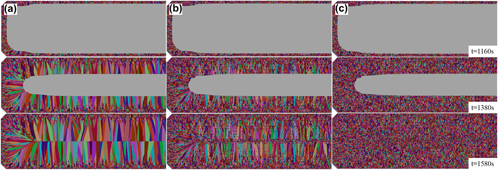Crossref Citations
This article has been cited by the following publications. This list is generated based on data provided by
Crossref.
Vutova, Katia
Vassileva, Vania
Stefanova, Vladislava
Amalnerkar, Dinesh
and
Tanaka, Takeshi
2019.
Effect of Electron Beam Method on Processing of Titanium Technogenic Material.
Metals,
Vol. 9,
Issue. 6,
p.
683.
Gao, Lei
Li, Xiang-ming
Huang, Hai-guang
Sui, Yu-dong
Zhang, Hong-ming
Shi, Zhe
Chattopadhyay, Kinnor
Jiang, Ye-hua
and
Zhou, Rong
2019.
Numerical study of aluminum segregation during electron beam cold hearth remelting for large-scale Ti-6 wt%Al-4 wt%V alloy round ingot.
International Journal of Heat and Mass Transfer,
Vol. 139,
Issue. ,
p.
764.
Gao, Lei
Huang, Haiguang
Jiang, Yehua
Chen, Guo
Chattopadhyay, Kinnor
and
Zhou, Rong
2020.
Numerical Study on the Solid–Liquid Interface Evolution of Large-Scale Titanium Alloy Ingots During High Energy Consumption Electron Beam Cold Hearth Melting.
JOM,
Vol. 72,
Issue. 5,
p.
1953.
Gao, Lei
Huang, Hai-guang
Kratzsch, Christoph
Zhang, Hong-ming
Chattopadhyay, Kinnor
Jiang, Ye-hua
and
Zhou, Rong
2020.
Numerical study of aluminum segregation during electron beam cold hearth melting for large-scale Ti-6 wt%Al-4 wt%V alloy slab ingots.
International Journal of Heat and Mass Transfer,
Vol. 147,
Issue. ,
p.
118976.
Peng, Bing-Bing
Li, Xiang-Ming
Wang, Xian
Mo, Jian
and
Luo, Lei
2021.
Simulation study on temperature field and microstructure of Ti-6Al-4V alloy round ingot during EBCHM.
Materials Research Express,
Vol. 8,
Issue. 4,
p.
046505.
Xu, Guanghua
Tao, Jieyan
Deng, Yajie
Zheng, Biju
Zhang, Yuqin
and
Jiang, Yehua
2022.
Multi-stage hot deformation and dynamic recrystallization behavior of low-cost Ti–Al–V–Fe alloy via electron beam cold hearth melting.
Journal of Materials Research and Technology,
Vol. 20,
Issue. ,
p.
1186.
Zhu, Zhenze
Li, Zulai
Zhou, Rongfeng
Huang, Haiguang
Xiong, Wentao
and
Li, Xiangming
2022.
Experimental verification of molybdenum segregation for large-scale slab ingots of Ti–0.3Mo–0.8Ni alloy during electron-beam cold-hearth melting.
Philosophical Magazine Letters,
Vol. 102,
Issue. 8-9,
p.
270.
Zhu, Mengmeng
Lv, Gaolin
Li, Xiangming
and
Zhou, Xu
2023.
Numerical simulation of cellular automaton in vacuum arc remelting during the solidification process.
Materials Research Express,
Vol. 10,
Issue. 4,
p.
046518.
Cui, Yu-Wei
Wang, Liqiang
and
Zhang, Lai-Chang
2024.
Towards load-bearing biomedical titanium-based alloys: From essential requirements to future developments.
Progress in Materials Science,
Vol. 144,
Issue. ,
p.
101277.
Wang, Yunpeng
Gao, Lei
Xin, Yuchen
Guo, Shenghui
Yang, Li
Ji, Haohang
and
Chen, Guo
2024.
Numerical Modeling of Electron Beam Cold Hearth Melting for the Cold Hearth.
Minerals,
Vol. 14,
Issue. 6,
p.
601.
Davis, A. E.
Wainwright, J.
Sahu, V. K.
Dreelan, D.
Chen, X.
Ding, J.
Flint, T.
Williams, S.
and
Prangnell, P. B.
2024.
Achieving a Columnar-to-Equiaxed Transition Through Dendrite Twinning in High Deposition Rate Additively Manufactured Titanium Alloys.
Metallurgical and Materials Transactions A,
Vol. 55,
Issue. 6,
p.
1765.
Cao, Wei
Ma, Chong
Li, Yang
Gao, Lei
Chen, Guo
and
Omran, Mamdouh
2024.
Numerical simulation study on solidification proceoss of titanium slab ingot by electron beam cold hearth melting.
Materials Research Express,
Vol. 11,
Issue. 8,
p.
086514.
Wang, Yunpeng
Xin, Yuchen
Gao, Lei
Cao, Wei
Ma, Chong
Guo, Shenghui
and
Chen, Guo
2024.
The Analysis of the Compositional Uniformity of a Ti-Al Alloy during Electron Beam Cold Hearth Melting: A Numerical Study.
Metals,
Vol. 14,
Issue. 8,
p.
884.




